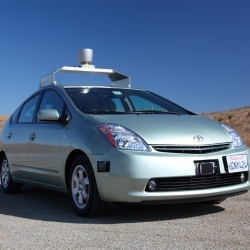
Futurists and science fiction writers have predicted for decades that one day smart robots would roll around town doing errands for us.
Today, that future seems still far off. But it’s just around the corner. It’s all thanks to Google, as well as car companies and universities that are making incredible advances in the technology for self driving cars.
Google’s Prius is already a better driver than you are
In 2004, I was invited by the Pentagon to cover a historic event in California’s Mojave desert: The DARPA Grand Challenge.
Google’s self-driving cars may soon appear on Nevada roads, where the state’s Department of Motor Vehicles approved the nation’s first autonomous vehicle license. (Reuters / Nevada Department of Motor Vehicles/Handout) DARPA, the U.S. military’s Defense Advanced Research Projects Agency, wanted to accelerate the development of self-driving cars for use on the battlefield. The agency challenged universities and private companies to enter their robotic vehicles in a contest — a 142-mile course that had to be navigated by self-driving cars, trucks and even a motorcycle. The winner would receive a cash prize.
None of the entries made it even to the 10-mile mark.
While robot cars couldn’t even handle a dirt road in the desert then, now they share the highways with us.
Google, for example, has developed a fleet of eight self-driving cars, including six Toyota Priuses, as well as an Audi and a Lexus.
A driver sits in the driver’s seat without doing anything and a Google engineer in the passenger seat. This is a precaution and, it turns out, an unnecessary one. Google’s self-driving cars have driven hundreds of thousands of miles on public roads without a single accident while under computer control. In fact, the most dangerous thing about Google’s self-driving car is the human driver. Once he or she takes the wheel, the risk of accident increases.
